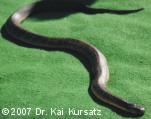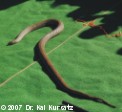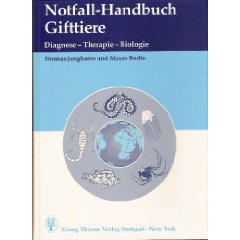|




| |
Pseudonaja textilis



Name: Gewöhnliche Braunschlange;
Eastern brown snake, Common Brown Snake
Alte Namen:
- Furina textilis
- Pseudoelaps superciliosus
- Demansia annulata
- Pseudoelaps kubingii
- Pseudoelaps sordellii
- Pseudoelaps kubinyi
- Pseudoelaps supercilliosus var. beckeri
- Diemennia superciliosa
- Diemenia superciliaris
- Pseudoelaps beckeri
- Furina bicucullata
- Furina cucullata
- Pseudechis cupreus
- Demansia textilis (inframaculata)
- Euprepiosoma textilis
Unterarten:
- Pseudonaja textilis textilis
- Pseudonaja textilis pughi
Vorkommen: Australien (New South
Wales, Northern Territory, Queensland, South Australia, Victoria, Western
Australia), Papua New Guinea (fraglich)
Anmerkung: Die ehemalige Unterart
Pseudonaja textilis inframacula hat nun als
Pseudonaja inframacula
einen eigenen Artstatus.
Allgemeines:
Neurologische Symptome sind nach Bissen durch Pseudonaja textilis selten, obwohl
sie einer der stärksten Gifte der Schlangen verfügt (zweitgiftigste
Landschlange). Vor allem im Osten Australiens verursacht diese Schlange
gefährliche Bisse. Die meisten Arten töten ihre Beute durch einen
Giftbiss und gleichzeitiges Umschlingen.
Beschreibung:
Die am Tag aktiven Spezies sind weit verbreitet. Es handelt sich um sehr
schlanke, lange und reaktionsschnelle Schlangen. Pseudonaja textilis kann eine
Länge bis zu 1,8 m erreichen. Die Färbung ist sehr unterschiedlich. Meistens
handelt es sich um helle beige, gelbe oder graue Farben. Die Tiere können auch
komplett braun gefärbt sein. Eine Musterung kann ebenfalls zu erkennen sein. Auf
Beutesuche werden weite Gebiete durchstreift, wobei Pseudonaja textilis und
Pseudonaja nuchalis
auch in die Vororte der größeren Städte eindringen. Alle
Brown snakes nehmen ein imposantes Abwehverhalten ein. Der vordere Körper wird
aufgerichtet, das Maul aufgerissen und spreizen den Nacken leicht ab. In dieser
Position wird die Bedrohung fixiert. Wirkt die Abschreckung nicht erfolgt ein
sehr schneller Biss. Durch die Haltung erfolgt ein relativ hoher Biss.
Toxine: Das Gift der
Braunschlangen enthält vor allem gerinnungshemmende und neurotoxische (prä- und
postsynaptische) Komponenten. Es ist extrem wirksam. Die Giftzähne sind sehr
kurz und die durchschnittliche Giftmenge je Biss ist vergleichsweise gering.
Symptome:
Jeder Biss durch die Schlange muss als lebensbedrohlich bewertet werden.
Übelkeit, Erbrechen, abdominelle Schmerzen, Kopfschmerzen, Blutdruckabfall,
Kreislaufkollaps, Bewusstseinsstörungen bis Bewusstlosigkeit, zerebrale
generalisierte Krampfanfälle, Blutungen aus alten Wunden und Punktionsstellen,
Hämatemesis, Hämaturie, Lähmungen, Nierenfunktionsstörungen bis zum akuten
Nierenversagen. Todesfälle sind bekannt. Atemlähmungen sind selten, aber
möglich. Bereits in der frühen Phase sind Herzstillstände möglich.
Eine Fallbeschreibung finden Sie hier:
Tödlicher Biss durch Pseudonaja textilis
Maßnahmen:
Hier ist die
"pressure/ immobilization-technique"
anzuwenden. Die Patienten müssen in den meisten Fällen sediert werden. Es
kann notwendig werden den Patienten zu intubieren und zu beatmen. Die weiteren
Maßnahmen erfolgen symptomatisch. In der Klinik kann eine Dialyse notwendig
werden. Es existiert ein Antivenin. Dies ist erst nach der Rücksprache mit einem
Giftinformationszentrums zu geben.
Literatur:
-

-
The Reptile Database
-
WCH Clinical Toxinology
-
GIZ München
-
Wikipedia
-
eMJA- Antivenom dosing in 35 patients with severe brown snake (Pseudonaja )
envenoming in Western Australia over 10 years
-
eMJA- Contents - 061204
-
eMJA- Snakebite in tropical Australia- a prospective study in the “Top End” of
the Northern Territory
-
eMJA- Antivenom, anecdotes and evidence
-
eMJA- Current use of Australian snake antivenoms and frequency of
immediate-type hypersensitivity reactions and anaphylaxis
- MJA-
Mead & Jelinek, Suspected snakebite in children- a study of 156 patients over
10 years
-
eMJA- Successful resuscitation after cardiac arrest following massive brown
snake envenomation
-
Crystal structure of textilinin-1, a Kunitz-type serine protease inhibitor
from the venom of the Australian common brown snake (Pseudonaja textilis).
-
Commercial monovalent antivenoms in Australia are polyvalent.
-
Venom factor V from the common brown snake escapes hemostatic regulation
through procoagulant adaptations.
-
Textilinin-1, an alternative anti-bleeding agent to aprotinin- Importance of
plasmin inhibition in controlling blood loss.
-
Distinct activities of novel neurotoxins from Australian venomous snakes for
nicotinic acetylcholine receptors.
-
Crystallization and preliminary X-ray analysis of a Kunitz-type inhibitor,
textilinin-1 from Pseudonaja textilis textilis.
-
Molecular diversity in venom from the Australian Brown snake, Pseudonaja
textilis.
-
Toxins not neutralized by brown snake antivenom.
-
Cloning and functional expression of venom prothrombin activator protease from
Pseudonaja textilis with whole blood procoagulant activity.
-
Snake envenomation in dogs in New South Wales.
-
The nonenzymatic subunit of pseutarin C, a prothrombin activator from eastern
brown snake (Pseudonaja textilis) venom, shows structural similarity to
mammalian coagulation factor V.
-
Influences on venom yield in Australian tigersnakes (Notechis scutatus) and
brownsnakes (Pseudonaja textilis- Elapidae, Serpentes).
-
A family of textilinin genes, two of which encode proteins with
antihaemorrhagic properties.
-
Effect of snake venom procoagulants on snake plasma- implications for the
coagulation cascade of snakes.
-
Textilinins from Pseudonaja textilis textilis. Characterization of two plasmin
inhibitors that reduce bleeding in an animal model.
-
Fatal brown snake (Pseudonaja textilis) envenomation despite the use of
antivenom.
-
Studies on the subunit structure of textilotoxin, a potent presynaptic
neurotoxin from the venom of the Australian common brown snake (Pseudonaja
textilis). 3. The complete amino-acid sequences of all the subunits.
-
The cardiovascular and haematological effects of purified prothrombin
activator from the common brown snake (Pseudonaja textilis) and their
antagonism with heparin.
-
Variation in the composition of the venom from a single specimen of Pseudonaja
textilis (common brown snake) over one year.
-
The efficacy of antivenom in prevention of cardiovascular depression and
coagulopathy induced by brown snake (Pseudonaja) species venom.
-
Studies on Australian snake venoms, Part II- The haematological effects of
brown snake (Pseudonaja) species in the dog.
-
Studies on the subunit structure of textilotoxin, a potent presynaptic
neurotoxin from the venom of the Australian common brown snake (Pseudonaja
textilis). 2. The amino acid sequence and toxicity studies of subunit D.
-
Studies on Australian snake venoms. Part 1- The haemodynamic effects of brown
snake (Pseudonaja) species in the dog.
-
Severe envenomation with convulsion following multiple bites by a common brown
snake, Pseudonaja textilis.
-
Acute renal failure after envenomation by the common brown snake.
-
Purification and characterization of a prothrombin activator from the venom of
the Australian brown snake, Pseudonaja textilis textilis.
-
Studies on the subunit structure of textilotoxin, a potent neurotoxin from the
venom of the Australian common brown snake (Pseudonaja textilis).
-
Pseudonajatoxin b- unusual amino acid sequence of a lethal neurotoxin from the
venom of the Australian common brown snake, Pseudonaja textilis.
-
The presynaptic neuromuscular blocking effect and phospholipase A2 activity of
textilotoxin, a potent toxin isolated from the venom of the Australian brown
snake, Pseudonaja textilis.
-
In vitro coagulant properties of venoms from Australian snakes.
-
First-aid for snake-bite- efficacy of a constrictive bandage with limb
immobilization in the management of human envenomation.
-
The effects of the subcutaneous injection of the crude venom of the Australian
common brown snake, Pseudonaja textilis on the skeletal neuromuscular system.
-
Effects of Australian Eastern brown snake (Pseudonaja textilis) venom on the
ultrastructure of nerve terminals on the rat diaphragm.
-
Envenomation by the Australian common brown snake--Pseudonaja (Demansia)
textilis textilis.
- The defensive strike of the
Eastern Brownsnake, Pseudonaja textilis (Elapidae)
|